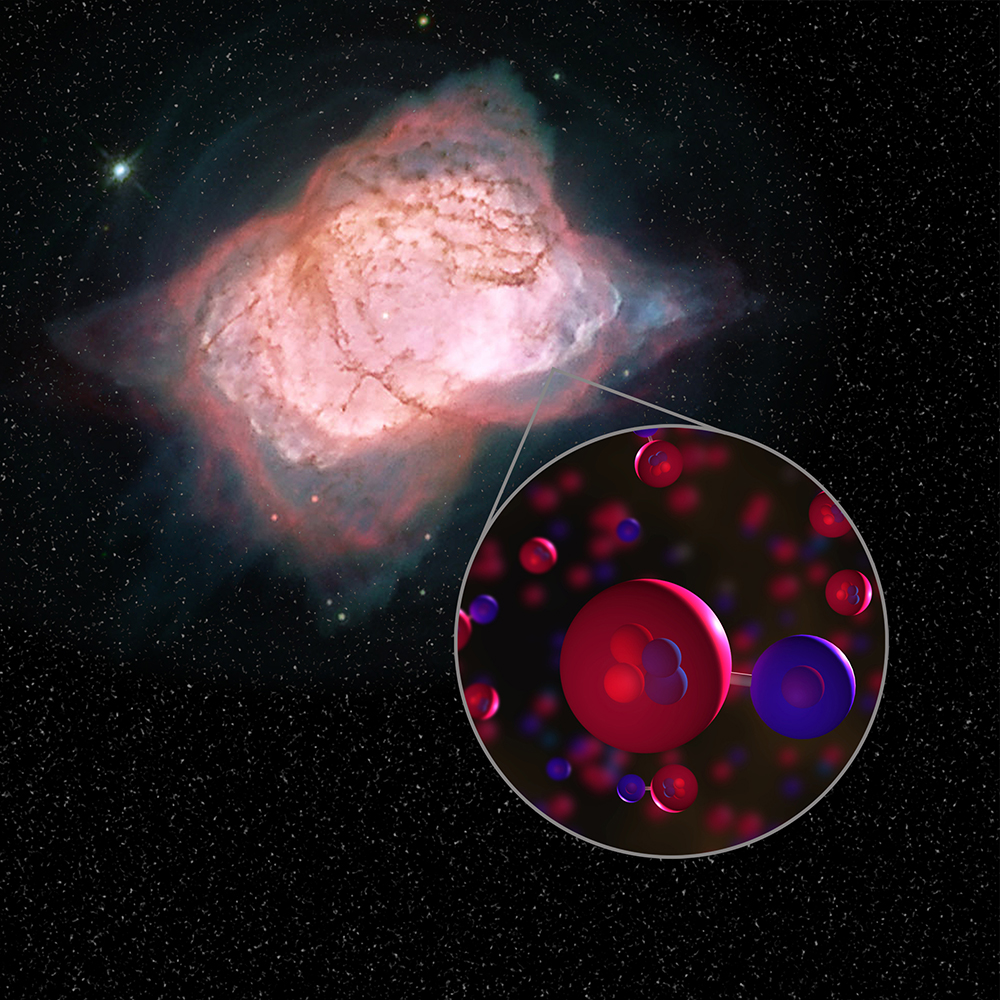After a decades-long search, astronomers have detected the signature of a molecule predicted as the first type to have ever formed in the universe. Called helium hydride and symbolized HeH+, this positively charged ion consists of a helium atom that shares one of its two electrons with the lone proton of a hydrogen nucleus. Hydrogen and helium represent the first chemical elements forged during the big bang 13.8 billion years ago. Initially, they would have bonded together into helium hydride, even before hydrogen atoms began pairing up as molecules, the most abundant sort in the universe thereafter and into present day. See also: Astronomy; Big bang theory; Chemical element; Chemistry; Helium; Hydrogen; Ion; Molecule; Physics; Universe

One reason spaceborne helium hydride has long resisted identification is that this molecule is highly reactive and thus short-lived. In fact, helium hydride is technically the strongest possible acid that can exist. Nevertheless, researchers successfully created the molecule in the laboratory in 1925. The molecule is further remarkable because it involves a chemical bonding with helium, which, as a noble gas, is usually chemically inert. See also: Acid and base; Chemical bonding; Noble gases; pH
In select circumstances, though, helium reacts. Such circumstances, scientists predicted, should exist in the clouds of matter in space known as nebulae—in particular, planetary nebulae. Named for their often circular, planet-like appearance in early telescopes, these nebulae are ejected into space by Sunlike stars as the stars age, expanding and then contracting down to objects called white dwarfs. Intense radiation emitted by white dwarfs is theorized to ionize helium and hydrogen within the gassy nebulae. In a temperature regime of a few thousand degrees Celsius, these conditions make an ideal astrophysical environment for the formation of helium hydride, mimicking conditions in the universe about 100,000 years post–big bang. See also: Gas; Ionization; Matter; Nebula; Planet; Planetary nebula; Radiation; Star; Sun; Temperature; White dwarf star
With the theoretical basis for a detection accordingly set, the remaining challenge became observational. Helium hydride's most powerful spectral line—in essence, a molecular fingerprint conveyed by light—is a wavelength in the far-infrared portion of the electromagnetic spectrum that is blocked by Earth's atmosphere. Space-based telescopes have not deployed the right kind of detectors, though. However, a unique high-flying telescope called SOFIA (Stratospheric Observatory for Infrared Astronomy), built into a modified Boeing 747 aircraft, proved to be up to the task. Back in 2016, SOFIA collected what turned out to be the telltale signal of helium hydride from the planetary nebula NGC 7027, located 3,000 light-years away in the constellation Cygnus. See also: Airplane; Astronomical observatory; Atmosphere; Constellation; Earth; Electromagnetism; Infrared astronomy; Infrared radiation; Light; Light-year; Spectrum; Telescope
Finding helium hydride at last fills the missing gap where the very first building block in the edifice of cosmic chemistry must go. That chemistry progressed to forming increasingly complex molecules, eventually including the self-replicating nucleic acids that serve as genetic blueprints in living organisms, including humans. See also: Biology; Cosmochemistry; Deoxyribonucleic acid (DNA); Nucleic acid; Ribonucleic acid (RNA)





